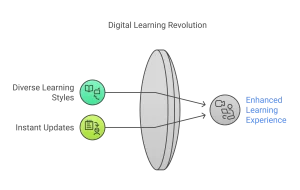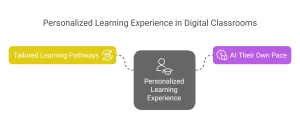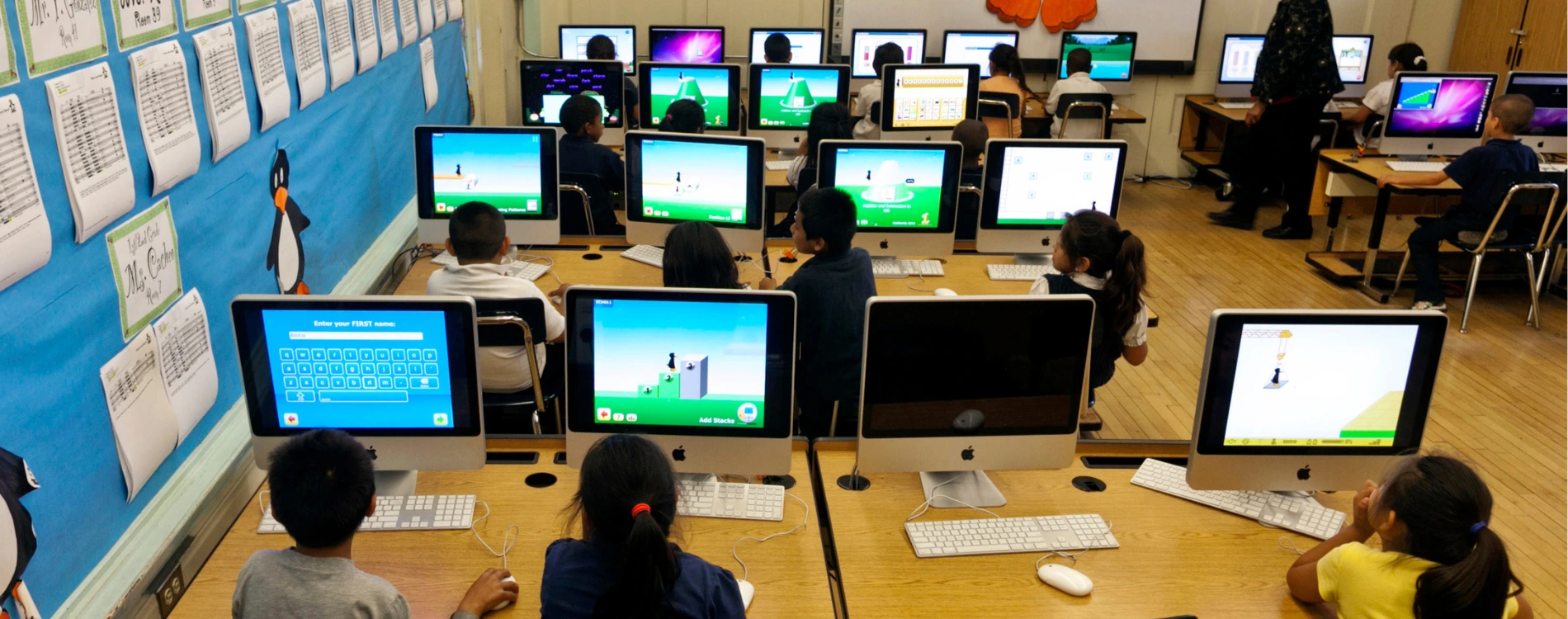Benefits of Creating Digital Classrooms in Schools
In the rapidly changing education landscape, digital classrooms have become a game-changer, holding immense potential for students and teachers. Although the conventional teaching environments have a role to play, the incorporation of digital tools in the classroom enhances the entire learning process to a great extent. By offering flexible learning prospects to enable innovative and engaging lesson plans, digital classrooms are transforming the way education takes place. This blog delves into the different advantages of establishing digital classrooms in schools.
1. Increased Access To Learning Resources
One of the most notable benefits of digital classes is the ability to access learning materials with such ease. Gone are the times when the students were dependent on textbooks and printed handouts. With digital classes, e-books, internet-based articles, videos, and simulations that can be interacted with, all come at the touch of a button.
A. Diversity Of Learning Styles
Students will be able to access content in a variety of media: text, audio, video, and interactive modules, so that learning doesn’t rely on a single medium. This accommodates different students with different learning styles, whether visual, auditory, or kinesthetic.
B. Instant Updates
In an e-classroom, the resources get updated in real time, so students remain aware of the most current knowledge. New resources, new assignments, and new announcements get uploaded in seconds by the instructor,s so everyone stays informed.

2. Flexibility And Convenience
Digital classroom environments enable students to learn at the time and in the manner that suits them best, offering a degree of flexibility that might not be possible in traditional classroom environments.
A. Self-Paced Learning
Students may repeat reviewing a lesson, rewinding videos, or retaking a quiz as many times as necessary to grasp a concept. Such self-directed learning benefits the students who need additional time to comprehend challenging subjects.
B. Learning Anytime, Anywhere
Digital classrooms dissolve time and location barriers. Students can take classes or watch lessons from anywhere at home, on vacation, or from another country. This allows education to be more accessible and inclusive to more people.
3. Enhancing Student Engagement
Traditional classroom environments sometimes lag in holding students’ interest, particularly with long lectures or tedious instruction. Digital courses bring in several different interactive aspects that will maintain the interest and motivation of students.
A. Interactive Tools
Digital classroom environments offer such tools as quizzes, polls, discussion boards, and live chat, all of which allow active participation from students. Such tools enhance the dynamic nature of learning and get students actively involved with the material and each other.
B. Gamified Learning
Some digital tools provide gamified learning, transforming the lessons into challenges or games. The gamified feature of such tools makes learning interesting and encourages students to learn more actively.
4. Personalized Learning Experience
All students have different learning requirements, and digital classrooms make it possible to adapt the lesson plans and resources to such personalized needs. Through the use of adaptive learning technologies, the lesson plans can be adapted to the specific requirements of each learner.
A. Tailored Learning Pathways
Digital classes use the power of analytics and evaluation tools to monitor the progress of every learner and make suggestions to improve areas of weakness. This enables instructors to establish customized pathways of learning, so students don’t get left behind and struggle to catch up.
B. At Their Own Pace
Students benefit from the liberty of learning at whatever pace they prefer in a digital classroom. Whether they must go slower and repeat concepts or accelerate through something they grasp quickly, the adaptability serves to support the style in which they learn.

5. Improved Student-Teacher Communication
Interaction between students and teachers plays a critical role in building a successful learning ecosystem. Digital classrooms enable students and teachers to remain connected and work together with greater ease.
A. Immediate Feedback
Feedback in a traditional classroom may be delayed at times. With digital platforms, however, the instructor can give instant feedback on quizzes, projects, and homework. Such timely feedback enables the students to know where they have gone wrong and improve promptly.
B. Open Channels Of Discussion
Digital classes usually feature forums, email services, and direct messaging capabilities, offering numerous avenues for students to contact the instructors. This can promote more open communication and make students more at ease asking questions or seeking clarification.
6. Cost-Effective Education
Digital classrooms not only provide advanced learning tools but also contribute significantly to reducing the costs associated with traditional education. With the ability to replace paper-based materials, physical textbooks, and even classroom infrastructure, schools can drastically lower their operational expenses.
A. Reduction In Paper Usage
One of the most notable cost-saving benefits is the reduction in paper usage. By transitioning to digital formats, schools can move away from printed materials such as textbooks, worksheets, and assignments. This not only cuts down on costs but also promotes sustainability by minimizing paper consumption, which is crucial in today’s environmentally-conscious world.
B. Lower Infrastructure Costs
In a traditional school setup, a significant portion of the budget is allocated to maintaining physical classroom spaces, purchasing furniture, and managing equipment. With digital classrooms, schools can reduce their reliance on costly infrastructure. Virtual assessments, online learning modules, and even virtual field trips can replace in-person activities, enabling schools to deliver high-quality education without the need for extensive physical resources.
7. Encouraging Collaboration And Teamwork
Digital classrooms play a key role in fostering collaboration among students, even beyond regular school hours. Through online tools, students can easily collaborate on group projects, share resources, and engage in interactive discussions, ensuring that teamwork and peer learning are at the core of the learning experience.
A. Virtual Group Work
Platforms that support collaborative learning, such as shared documents, virtual whiteboards, and discussion boards, enable students to work together on assignments or projects in real-time, regardless of their physical location. This collaborative approach helps students build essential skills like communication, problem-solving, and critical thinking, which are vital for success in both academics and future careers.
B. Peer-To-Peer Learning
Digital classrooms also promote peer-to-peer learning, where students can freely exchange ideas, share resources, and offer support to one another. This peer-to-peer interaction not only deepens understanding but also creates a sense of community, helping students feel more connected and motivated to learn.
8. Enhancing Teacher Skills And Professional Development
Digital classrooms don’t just benefit students; they also provide opportunities for teachers to enhance their teaching practices and stay ahead of evolving educational trends. With a range of tools and resources at their disposal, teachers can continuously improve their skills and adapt to modern teaching methodologies.
A. Access To Training Resources
Teachers now have access to a wide array of online training resources, such as workshops, webinars, and educational courses. These resources allow teachers to stay informed about the latest teaching strategies, technology tools, and subject knowledge, ensuring they can provide the best possible learning experience for their students.
B. Efficient Lesson Planning
Digital platforms streamline lesson planning by offering pre-designed templates, multimedia resources, and interactive elements that can be easily integrated into lessons. Teachers can focus more on delivering engaging content and less on administrative tasks, resulting in more effective and dynamic lessons.
Conclusion
Integrating digital classrooms in schools offers countless benefits that go beyond the obvious use of technology. From providing greater access to learning materials and improving student engagement to promoting collaboration and teamwork, digital classrooms create a more dynamic and inclusive learning environment. Additionally, the flexibility of digital tools allows teachers to personalize their approach, enhance their skills, and focus on meaningful student-teacher interactions.
By embracing digital classrooms, schools are not only ensuring that students have access to a modern, effective learning experience but also making education more accessible, cost-effective, and sustainable. As technology continues to evolve, digital classrooms will play an increasingly important role in shaping the future of education, ensuring that students are well-prepared for the challenges of tomorrow.

